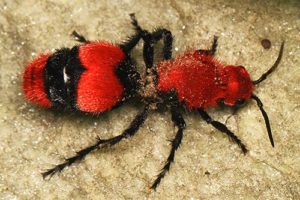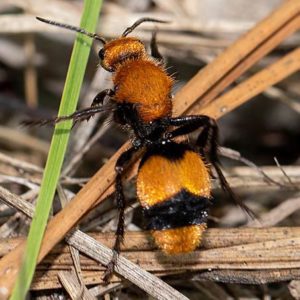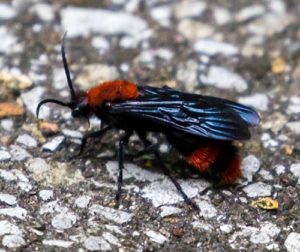Overview
Velvet ants aren’t really ants at all, but instead are a type of wasp. There are thousands of species of velvet ants worldwide with over 400 species being found in the continental U.S. and Canada. According to the University of Florida, 50 species can be found in that state alone. The most common, or at least the most noticed, species in much of the eastern U.S. is the eastern red velvet ant (Dasymutilla occidentalis).

What’s in a Name?
Most of us simply call the eastern red velvet ant a “velvet ant” or sometimes by the more colorful name of “cow killer.” In fact, until recently I didn’t realize there were other species of velvet ants. Over the years, I would occasionally stumble upon another insect that looked somewhat similar. I always assumed it was likely “something else” mimicking a velvet ant. Instead, they were likely other species of velvet ants that were part of the same complex mimicry ring.
(Many species of velvet ants that live in the same general area will have similar colorations and form what scientists call a mimicry ring. There are at least 8 different velvet ant mimicry rings in North America, with most being in the western part of the country. Since all the species in the same mimicry ring look similar, they all benefit from each other because potential predators learn to avoid anything that generally looks like them.)
Despite the implications of the more fun name of “cow killer,” the eastern red velvet ant’s sting is not strong enough to kill a cow. From what I’ve been told, it hurts, but not bad enough to kill a cow. Scientific analysis of the venom actually shows that it is less potent than honey bee venom. It’s the pain from the sting itself, not necessarily the venom, that punches the wallop, at least for humans. Even then, “cow killer” is a major over exaggeration.
One researcher, Dr. Justin Schmidt, has made a study of how badly different ant, bee, and wasp stings hurt. According to his pain scale, the eastern red velvet ant ranks as worse than a honey bee sting, but about on par with a paper wasp sting. I’ve never been stung by an eastern red velvet ant, so I can’t add any personal commentary, except to say that still doesn’t sound like fun. Plus, I’m weird. I think honey bee stings hurt worse than wasp stings.

What Do Eastern Red Velvet Ants Look Like?
This is our largest species of velvet ant in the eastern U.S. It can be almost an inch long. As the common name implies, the eastern red velvet ant looks like a large ant that is covered in red velvet. Most of the ones I see are a beautiful, rich, scarlet red, but they can be more of an orange-red color too. Its legs are a dark black and it has a dark black band on its abdomen. The belly is also black, but you’ll rarely see its underside. Females are wingless and bulkier, while the males have black wings and are slenderer. (For whatever reason, the females tend to be noticed more often. I’ve seen and been asked about lots of females, but don’t recall ever seeing a male and have never been asked to identify a male eastern red velvet ant.)
Where and When to Look for Them
The eastern red velvet ant can be found throughout much of the eastern half of the U.S. It likes sunny, open areas. The females are most often found crawling along the ground, but they can also be found on flowers. Although, eastern red velvet ants are active throughout the spring, summer, and fall, I see them most often during the warmer summer and early fall months.
Life History
Eastern red velvet ants are solitary, parasitoid wasps. The males fly near the ground to look for a female who is ready to mate. After mating, the female crawls along the ground looking for the nesting burrow of a host bee. Scientists don’t appear to be sure what species the eastern red velvet ant uses as a host. The earliest report, made in 1943, suggested that the host was a specific bumble bee species, which was extrapolated to possibly all bumble bees. However, nobody else has made the same observation and more recent studies indicate that the host is likely the cicada killer wasp and / or a couple of other ground nesting wasp species.

Whatever the host species is, the female eastern red velvet ant will find and enter the nest of its host species. She then lays one egg on each of the host larva that has begun the pupation process. After her egg hatches, the eastern red velvet ant larva will devour the pupa of the host species before pupating itself and then later emerging as an adult. Adults most likely feed on nectar, although there doesn’t appear to be much research on this subject either.
Eastern red velvet ants have few natural predators due to a very extensive and complex defense system. Their bright red and black coloration is a classic warning signal in the animal kingdom. The painful, venom-laced sting that has made them so infamous provides a quick and memorable education for any predator that attempts to ignore the warning colors. All of the species in the mimicry ring that exhibit the same color patterns reinforces the message of “don’t mess with us.” So, most potential predators quickly learn to leave the furry red and black bugs alone. However, it is actually only the females that can sting. The males lack a stinger, although if caught, they will pretend to sting by jabbing any potential predator with their reproductive parts.
In addition to the obvious coloration and sting defenses, eastern red velvet ants have a number of other defense mechanisms. The males can fly away and the females can run pretty quickly for an insect of their size. If pestered or caught, they can create a squeaky noise which they will often make as a final warning before stinging anything. They also have a chemical that can exude from their body and gives a “stinky stay away” warning to many potential insect predators. If all that wasn’t enough, their exoskeletons are really tough – much tougher than that of a honey bee or most other insects their size. The tough exoskeleton makes it harder for predators that do grab them to puncture or crush it, therefore, giving the red velvet ant a better chance of surviving if it can get away.
What to Do if You Find One
Although eastern red velvet ants can deliver a good wallop if you get stung, they really aren’t anything to worry about. They are not aggressive and will only sting if picked up, stepped on, or something like that. If you have children around, teach them about the eastern red velvet ant and that they shouldn’t mess with it. Even as a child who was constantly running around barefooted (Mom couldn’t keep shoes on me during the summer) I never stepped on one. They just weren’t that common, and it seems like I saw them more often back then than I see them today.
Summary
Eastern red velvet ants are a beautiful species of parasitoid wasp. Much of the research on this species has focused on their sting and other defense mechanisms, but there is still so much that we don’t know about them. Despite the fear factor that is sometimes associated with them, finding eastern red velvet ants on your property can actually be seen as a good thing. It means that you have some sort of other ground nesting bee or wasp on your property – many of which are important pollinators or play other important roles in the ecosystem – and it means that you have a fully functioning ecosystems that includes both predators and prey.

Backyard Ecology: Exploring Nature in Your Backyard
Nature isn’t just “out there.” It’s all around us, including right outside our doors. Hi, my name is Shannon Trimboli, and I am the host of Backyard Ecology. I live in southcentral Kentucky and am a wildlife biologist, educator, author, beekeeper, and owner of a nursery specializing in plants for pollinators and wildlife conservation. I invite you to join me as we ignite our curiosity and natural wonder, explore our yards and communities, and improve our local pollinator and wildlife habitat. Learn more or subscribe to my email list at www.backyardecology.net.

Leave a Reply